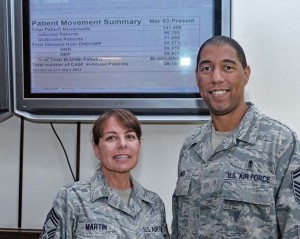
Airmen from the 920th Aeromedical Staging Squadron and the 920th Rescue Wing finished their final annual tour as part of Team Ramstein after a decade of continuous service.
Reservists from the 920th RW and ASTS have been working at the Contingency Aeromedical Staging Facility since the ribbon cutting ceremony in 2003.
Over the past decade, these reservists have been responsible for supplying up to 90 percent of the manpower and have helped to aid in nearly 142,000 patient movements. “Initially the billets for the CASF were split evenly,” said Senior Master Sgt. Anthony James, 920th ASTS superintendent of operations and programs.
“During our peak, reservists, who all volunteered to travel and do a tour in Germany, filled nearly 90 percent of the positions here. Our Airmen worked the standard shift that everyone else did and were undecipherable from any of the active duty members.”
James’ first tour on Ramstein was in 2007. Since then he has volunteered and served on an annual rotation. “We want our Airmen to see a picture bigger than themselves,” said Chief Master Sgt. Lori Martin, 920th ASTS health service manager.
“We want to show them how they serve the wounded warriors and show them that what they do matter even if they don’t have direct contact when back at home station.” Capabilities and readiness provided by the 920th RW doesn’t stop at Ramstein.
“We have a unique capability of how we can bring an injured service member, from any nation, off the battlefield,” said Col. Robert Ament, 920th RW vice commander. “We can then transport and care for any wounded warrior directly from a battlefield to a field hospital, onto Landstuhl Regional Medical Center and then again transport and care for them till they reach their destination in the states.
It is possible for a wounded warrior to be cared for by a member of the 920th RW at every stage of their recovery.” However, providing prestige care of wounded warriors is the mission of both the CASF and the 920th RW. “The wounded warriors need everyone,” said Martin. “The key is patient care and with the size of the mission here any type of volunteer is appreciated.”
Lessons and experiences gained from working at the CASF have also left lasting impressions on the reservists who have rotated through. “It’s hard to grasp the importance of the mission here, but I try to picture it as five key points,” said James. “The first is A, for what an amazing opportunity this is to come out and get to work hands on with wounded warriors. E, is the exceptional work done with everyone involved at all stages to get the mission done.
I, is for the fact that I’m humbled for this opportunity to continually come back here and work on this mission. O, is for the obvious mission we have that continually goes on that I think some people forget. Finally, it’s U, for the you in everybody that fuses together here to help the wounded warriors and complete the mission here.”
Reminding those who might have forgotten why they serve this mission was the final keystone. “The U.S. is the premier military in the world,” said Ament. “Not because of what we can accomplish on the battlefield, but for how we take care of our own.
Ensuring every last Sailor, Soldier, Marine and Airmen has the opportunity to return home with honor.”


